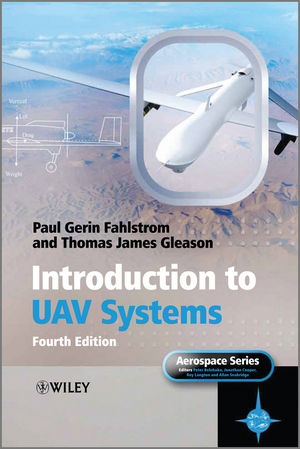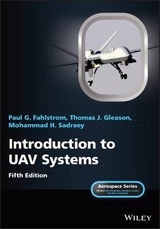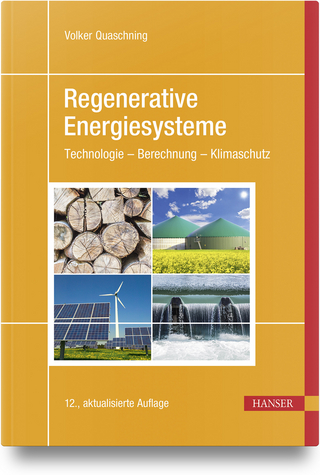
Introduction to UAV Systems 4e
John Wiley & Sons Inc (Verlag)
978-1-119-97866-4 (ISBN)
- Titel erscheint in neuer Auflage
- Artikel merken
Unmanned aerial vehicles (UAVs) have been widely adopted in the military world over the last decade and the success of these military applications is increasingly driving efforts to establish unmanned aircraft in non-military roles. Introduction to UAV Systems, 4th edition provides a comprehensive introduction to all of the elements of a complete Unmanned Aircraft System (UAS). It addresses the air vehicle, mission planning and control, several types of mission payloads, data links and how they interact with mission performance, and launch and recovery concepts. This book provides enough information to encourage a student to learn more; to provide a specialist with a basic appreciation of the technical issues that drive other parts of the system and interact with their specialty; or to help a program manager understand system-level tradeoffs and know what questions to ask. Key features: * Comprehensive overview of all elements of a UAS and of how they interact. * Introduces the underlying concepts of key subsystems. * Emphasizes system-integration issues and how they relate to subsystem design choices. * Practical discussion of issues informed by lessons learned in UAV programs.
Introduction to UAV Systems, 4th edition is written both for newcomers to the subject and for experienced members of the UAV community who desire a comprehensive overview at the system level. As well as being a primary text for an introductory course on UAS or a supplementary text in a course that goes into more depth in one of the individual technologies involved in a UAS, this book is a useful overview for practicing engineers, researchers, managers, and consultants interested in UAV systems.
Col Paul G Fahlstrom, USMC, Retd., USA Paul G. Fahlstrom began his career as aNaval Aviator (Marine Pilot). After completing active duty he worked for the Navy and subsequently joined NASA at the Goddard Space flight Center specializing in flight controls. Following six years with Goddard I became the government project engineer responsible for the Supersonic Transport (SST) flight control system, later moving to the Department of Transportation where he was responsible for reviewing R&D. He subsequently joined the Aviation Division of the Army Material Command as a Weapon Systems Staff Manager responsible for management of the Army&'s Unmanned Aerial Vehicle systems. Dr. Thomas J Gleason, Consultant, USA Dr. Thomas Gleason founded Gleason research Associates to conduct engineering and scientific analyses and evaluations related to missile and sensor systems. Prior to founding GRA, Dr. Gleason performed engineering and scientific analyses of the target acquisition sensors and laser designator of the Aquila Unmanned Aerial Vehicle (UAV). Dr. Gleason is a graduate of The Johns Hopkins University where he received a Bachelor of Arts, and a Ph.D in Physics.He completed Military education through Command and General Staff College and retired from the Army Reserve as a Lieutenant Colonel. Dr. Gleason is a member of the American Physical Society and is a recipient of the Harry Diamond Laboratories R&D Achievement Award and the Cogswel Award (as Facility Security Officer of GRA, for outstanding Industrial Security program). He is the Author or Co-author of over 100 technical reports related to his areas of expertise.
Preface xv Series Preface xix Acknowledgments xxi List of Acronyms xxiii Part One Introduction 1 History and Overview 3 1.1 Overview 3 1.2 History 4 1.2.1 Early History 4 1.2.2 The Vietnam War 5 1.2.3 Resurgence 5 1.2.4 Joint Operations 6 1.2.5 Desert Storm 6 1.2.6 Bosnia 6 1.2.7 Afghanistan and Iraq 7 1.3 Overview of UAV Systems 7 1.3.1 Air Vehicle 8 1.3.2 Mission Planning and Control Station 8 1.3.3 Launch and Recovery Equipment 9 1.3.4 Payloads 10 1.3.5 Data Links 10 1.3.6 Ground Support Equipment 11 1.4 The Aquila 11 1.4.1 Aquila Mission and Requirements 12 1.4.2 Air Vehicle 12 1.4.3 Ground Control Station 13 1.4.4 Launch and Recovery 13 1.4.5 Payload 13 1.4.6 Other Equipment 14 1.4.7 Summary 14 References 15 2 Classes and Missions of UAVs 17 2.1 Overview 17 2.2 Examples of UAV Systems 17 2.2.1 Very Small UAVs 18 2.2.2 Small UAVs 19 2.2.3 Medium UAVs 20 2.2.4 Large UAVs 23 2.3 Expendable UAVs 25 2.4 Classes of UAV Systems 26 2.4.1 Classification by Range and Endurance 26 2.4.2 Informal Categories of Small UAV Systems by Size 27 2.4.3 The Tier System 27 2.4.4 Another Classification Change 28 2.5 Missions 28 Reference 31 Part Two The Air Vehicle 3 Basic Aerodynamics 35 3.1 Overview 35 3.2 Basic Aerodynamic Equations 35 3.3 Aircraft Polar 39 3.4 The Real Wing and Airplane 40 3.5 Induced Drag 41 3.6 The Boundary Layer 43 3.7 Flapping Wings 46 3.8 Total Air-Vehicle Drag 48 3.9 Summary 48 References 49 Bibliography 49 4 Performance 51 4.1 Overview 51 4.2 Climbing Flight 51 4.3 Range 53 4.3.1 Range for a Propeller-Driven Aircraft 54 4.3.2 Range for a Jet-Propelled Aircraft 56 4.4 Endurance 57 4.4.1 Endurance for a Propeller-Driven Aircraft 57 4.4.2 Endurance for a Jet-Propelled Aircraft 58 4.5 Gliding Flight 59 4.6 Summary 59 5 Stability and Control 61 5.1 Overview 61 5.2 Stability 61 5.2.1 Longitudinal Stability 62 5.2.2 Lateral Stability 64 5.2.3 Dynamic Stability 65 5.2.4 Summary 65 5.3 Control 65 5.3.1 Aerodynamic Control 65 5.3.2 Pitch Control 66 5.3.3 Lateral Control 67 5.4 Autopilots 67 5.4.1 Sensor 68 5.4.2 Controller 68 5.4.3 Actuator 68 5.4.4 Airframe Control 68 5.4.5 Inner and Outer Loops 68 5.4.6 Flight-Control Classification 69 5.4.7 Overall Modes of Operation 70 5.4.8 Sensors Supporting the Autopilot 70 6 Propulsion 73 6.1 Overview 73 6.2 Thrust Generation 73 6.3 Powered Lift 75 6.4 Sources of Power 78 6.4.1 The Two-Cycle Engine 78 6.4.2 The Rotary Engine 81 6.4.3 The Gas Turbine 82 6.4.4 Electric Motors 83 6.4.5 Sources of Electrical Power 84 7 Loads and Structures 91 7.1 Overview 91 7.2 Loads 91 7.3 Dynamic Loads 94 7.4 Materials 96 7.4.1 Sandwich Construction 96 7.4.2 Skin or Reinforcing Materials 97 7.4.3 Resin Materials 97 7.4.4 Core Materials 98 7.5 Construction Techniques 98 Part Three Mission Planning and Control 8 Mission Planning and Control Station 101 8.1 Oerview 101 8.2 MPCS Architecture 105 8.2.1 Local Area Networks 107 8.2.2 Elements of a LAN 107 8.2.3 Levels of Communication 108 8.2.4 Bridges and Gateways 110 8.3 Physical Configuration 111 8.4 Planning and Navigation 113 8.4.1 Planning 113 8.4.2 Navigation and Target Location 115 8.5 MPCS Interfaces 117 9 Air Vehicle and Payload Control 119 9.1 Overview 119 9.2 Modes of Control 120 9.3 Piloting the Air Vehicle 120 9.3.1 Remote Piloting 121 9.3.2 Autopilot-Assisted Control 121 9.3.3 Complete Automation 122 9.3.4 Summary 123 9.4 Controlling Payloads 123 9.4.1 Signal Relay Payloads 124 9.4.2 Atmospheric, Radiological, and Environmental Monitoring 124 9.4.3 Imaging and Pseudo-Imaging Payloads 125 9.5 Controlling the Mission 126 9.6 Autonomy 128 Part Four Payloads 10 Reconnaissance/Surveillance Payloads 133 10.1 Overview 133 10.2 Imaging Sensors 134 10.2.1 Target Detection, Recognition, and Identification 134 10.3 The Search Process 146 10.4 Other Considerations 152 10.4.1 Stabilization of the Line of Sight 152 References 156 Bibliography 156 11 Weapon Payloads 157 11.1 Overview 157 11.2 History of Lethal Unmanned Aircraft 158 11.3 Mission Requirements for Armed Utility UAVs 161 11.4 Design Issues Related to Carriage and Delivery of Weapons 161 11.4.1 Payload Capacity 161 11.4.2 Structural Issues 162 11.4.3 Electrical Interfaces 163 11.4.4 Electromagnetic Interference 165 11.4.5 Launch Constraints for Legacy Weapons 165 11.4.6 Safe Separation 166 11.4.7 Data Links 166 11.5 Other Issues Related to Combat Operations 166 11.5.1 Signature Reduction 166 11.5.2 Autonomy 176 Reference 179 12 Other Payloads 181 12.1 Overview 181 12.2 Radar 181 12.2.1 General Radar Considerations 181 12.2.2 Synthetic Aperture Radar 183 12.3 Electronic Warfare 184 12.4 Chemical Detection 184 12.5 Nuclear Radiation Sensors 185 12.6 Meteorological Sensors 185 12.7 Pseudo-Satellites 186 Part Five Data Links 13 Data-Link Functions and Attributes 191 13.1 Overview 191 13.2 Background 191 13.3 Data-Link Functions 193 13.4 Desirable Data-Link Attributes 194 13.4.1 Worldwide Availability 195 13.4.2 Resistance to Unintentional Interference 196 13.4.3 Low Probability of Intercept (LPI) 196 13.4.4 Security 197 13.4.5 Resistance to Deception 197 13.4.6 Anti-ARM 197 13.4.7 Anti-Jam 198 13.4.8 Digital Data Links 199 13.5 System Interface Issues 199 13.5.1 Mechanical and Electrical 199 13.5.2 Data-Rate Restrictions 200 13.5.3 Control-Loop Delays 201 13.5.4 Interoperability, Interchangeability, and Commonality 202 Reference 204 14 Data-Link Margin 205 14.1 Overview 205 14.2 Sources of Data-Link Margin 205 14.2.1 Transmitter Power 206 14.2.2 Antenna Gain 206 14.2.3 Processing Gain 213 14.3 Definition of AJ Margin 217 14.3.1 Jammer Geometry 218 14.3.2 System Implications of AJ Capability 222 14.3.3 Anti-Jam Uplinks 224 14.4 Propagation 225 14.4.1 Obstruction of the Propagation Path 225 14.4.2 Atmospheric Absorption 226 14.4.3 Precipitation Losses 227 14.5 Data-Link Signal-to-Noise Budget 227 References 229 15 Data-Rate Reduction 231 15.1 Overview 231 15.2 Compression Versus Truncation 231 15.3 Video Data 232 15.4 Non-Video Data 239 15.5 Location of the Data-Rate Reduction Function 240 References 241 16 Data-Link Tradeoffs 243 16.1 Overview 243 16.2 Basic Tradeoffs 243 16.3 Pitfalls of Putting Off Data-Link Issues 245 16.4 Future Technology 246 Part Six Launch and Recovery 17 Launch Systems 249 17.1 Overview 249 17.2 Basic Considerations 249 17.3 UAV Launch Methods for Fixed-Wing Vehicles 253 17.3.1 Rail Launchers 254 17.3.2 Pneumatic Launchers 255 17.3.3 Hydraulic/Pneumatic Launchers 256 17.3.4 Zero Length RATO Launch of UAVs 257 17.4 Vertical Takeoff and Landing UAV Launch 260 18 Recovery Systems 261 18.1 Overview 261 18.2 Conventional Landings 261 18.3 Vertical Net Systems 262 18.4 Parachute Recovery 263 18.5 VTOL UAVs 265 18.6 Mid-Air Retrieval 267 18.7 Shipboard Recovery 269 19 Launch and Recovery Tradeoffs 271 19.1 UAV Launch Method Tradeoffs 271 19.2 Recovery Method Tradeoffs 274 19.3 Overall Conclusions 276 Index 277
| Erscheint lt. Verlag | 17.9.2012 |
|---|---|
| Reihe/Serie | Aerospace Series (PEP) |
| Verlagsort | New York |
| Sprache | englisch |
| Maße | 170 x 244 mm |
| Gewicht | 612 g |
| Themenwelt | Technik ► Elektrotechnik / Energietechnik |
| Technik ► Fahrzeugbau / Schiffbau | |
| Technik ► Luft- / Raumfahrttechnik | |
| Technik ► Maschinenbau | |
| ISBN-10 | 1-119-97866-1 / 1119978661 |
| ISBN-13 | 978-1-119-97866-4 / 9781119978664 |
| Zustand | Neuware |
| Informationen gemäß Produktsicherheitsverordnung (GPSR) | |
| Haben Sie eine Frage zum Produkt? |
aus dem Bereich



